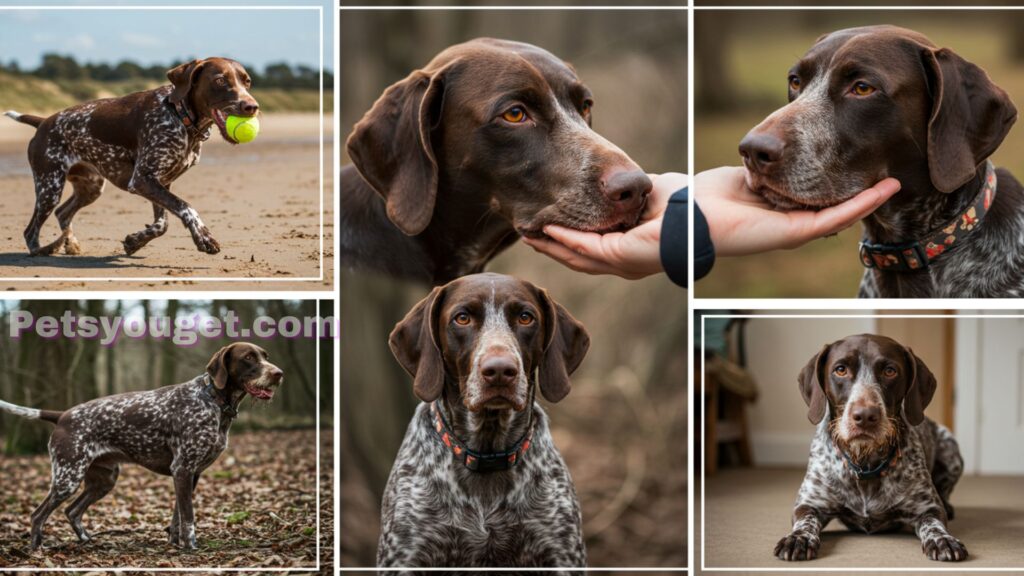German Shorthaired Pointer: A Dynamic Companion
The German Shorthaired Pointer (GSP) is a versatile, energetic breed known for its athleticism and intelligence. Originating from Germany, these dogs were originally bred as multipurpose hunting dogs, excelling in both land and water activities. With their sleek coat available in a variety of colors and patterns, GSPs are not just good-looking but also come with a natural talent for hunting, pointing, and tracking game. Their sharp sense of smell and enduring stamina make them an ideal choice for field trials and other agility competitions. Whether it’s hunting in rugged terrains or running beside you during outdoor adventures, their athletic build and energy are sure to keep up.
The German Shorthaired Pointer is not only known for its physical traits but also its friendly and outgoing nature. Their loyalty and affection towards human companions make them great family pets, and their gentle disposition makes them a hit with children and other pets. However, like all dogs with a strong instinctual prey drive, they may need a bit of extra socialization when it comes to getting along with smaller pets like rabbits. With proper training, GSPs form strong connections with their families, showcasing a remarkable level of trainability and obedience. Their energetic personality also makes them excellent partners in outdoor activities, keeping their owners engaged and entertained.

When adopting a German Shorthaired Pointer, it’s crucial to make sure you’re sourcing from a reputable breeder or rescue organizations that focus on the dog’s well-being. It’s important to research and ensure the breeder follows ethical practices that guarantee the dog’s health and temperament are at the forefront. This breed is often sought after for its trainability and remarkable intelligence, but these traits must be nurtured in a loving home environment. Neglecting to adopt these practices may lead to health issues or behavioral problems later on. For those ready to give a GSP the loving home they deserve, the reward is a healthy pup and a happy pup.
Points:
- German Shorthaired Pointer is a multipurpose hunting dog with strong athletic traits.
- GSPs are known for their sharp sense of smell and enduring stamina.
- Their friendly and outgoing nature makes them great companions for children and other pets.
- Proper socialization and training are key to ensuring positive interactions with smaller pets.
- Always choose a reputable breeder or rescue organization to ensure a healthy and happy GSP.
Quick Facts
| Quick Fact | Details |
|---|---|
| Origin | Germany |
| Breed Group | Sporting |
| Height | 22-25 inches (male), 21-23 inches (female) |
| Weight | 55-70 pounds (male), 45-60 pounds (female) |
| Lifespan | 12-14 years |
| Temperament | Friendly, intelligent, eager to please, energetic, and affectionate |
| Grooming Needs | Moderate (requires regular brushing) |
| Exercise Requirements | High (ideal for active families or individuals who enjoy outdoor activities) |
| Training | Generally easy to train, though may show some stubbornness if not consistently guided |
| Health Considerations | Prone to hip dysplasia, elbow dysplasia, eye conditions, and bloat |
| Famous Owners | Bradley Cooper, Tim McGraw, Chase Bryant |
| Pop Culture | Featured in a cameo appearance in Disney’s live-action *101 Dalmatians* (1996) |
What are the disadvantages of German Shorthaired Pointers?
German Shorthaired Pointers (GSPs) are known for their high energy levels and strong hunting instincts, but these traits can pose challenges for owners. The breed requires regular exercise and plenty of physical activity to stay happy and healthy. Without sufficient time and resources for exercise, GSPs may become bored and develop destructive behaviors. Their stubborn streak can make training a bit more demanding, requiring consistent training and patient training to ensure they remain well-behaved. If not properly engaged, they might exhibit unwanted behaviors like chasing small animals or birds, which can be problematic in environments where other pets are present.
While German Shorthaired Pointers are trainable and intelligent, they can sometimes be too independent, making them a challenge for owners who are not ready for a dog that demands both time and attention. GSPs are best suited for active households with ample space and an owner who can dedicate time to meet their exercise and training needs. In environments where they aren’t given enough stimulation, their strong hunting instincts can lead to trouble, particularly with smaller pets. Therefore, it’s important to be prepared for the challenges that come with owning a German Shorthaired Pointer.
German Shorthaired Pointer Dog Breed Pictures

German Shorthaired Pointer Overview
The German Shorthaired Pointer (GSP) is a highly versatile and elegant breed, known for its incredible hunting skills and as a loving family companion. With a distinctive appearance featuring a chiseled head, dark almond-shaped eyes, and broad, dropped ears, this breed stands out with its regal presence. The GSP is not just a hunting dog, excelling in tasks like tracking and retrieving feathered prey, furred prey, and even deer. They are equally skilled at pointing, making them ideal for upland birds, waterfowl, and even rabbits and raccoons. Their short, sleek coat with patterns such as solid liver, liver and white, and roan also contribute to their charm and appeal.
These energetic and intelligent dogs require plenty of exercise to stay happy and healthy. Whether it’s hiking, jogging, or playing with kids, the GSP thrives when engaging in physical activity. Their webbed feet and water-resistant coat make them natural swimmers, perfect for water dog activities. With a natural ability to please, the GSP is an eager learner who responds well to praise and food rewards, quickly grasping new exercises. However, their assertive hunting instincts can lead to challenges with smaller pets or strangers if not properly socialized.
Despite their strong drive for hunting, these dogs are loyal and affectionate, and form a special bond with their human companions. They enjoy snuggling with their family and are known for their good-humored expression. While they may exhibit some boisterous behaviors due to their high energy, they are not stubborn and generally get along well with children and other pets when trained consistently.
Points:
- Hunting Skills: The GSP excels at tracking and retrieving, making it a reliable companion for various hunting tasks like pointing and retrieving birds, rabbits, and even deer.
- Appearance: The breed has a regal appearance, with a chiseled head, almond-shaped eyes, and dropped ears, giving it a unique and appealing look.
- Energy Levels: Known for their high energy, they require regular exercise like hiking, jogging, and swimming to stay happy and healthy.
- Affectionate Nature: Despite their hunting instincts, GSPs are affectionate and form a deep bond with their families, enjoying activities like snuggling with kids.
- Training and Intelligence: GSPs are intelligent, eager to please, and respond well to training, especially when food rewards or praise are involved.
- Water Skills: Their webbed feet and water-resistant coat make them excellent swimmers, ideal for water activities or jobs like retrieving waterfowl.
- Temperament: The GSP is generally outgoing and friendly, but their strong hunting instincts can lead to challenges with strangers and smaller pets, requiring early socialization.
German Shorthaired Pointer Highlights

1. Versatility in Tasks
German Shorthaired Pointers excel in a variety of tasks, from hunting birds and mammals to being loyal family companions. Their ability to perform multiple roles makes them an adaptable breed.
2. Intelligent and Trainable
Renowned for their intelligence, German Shorthaired Pointers are quick learners and easily pick up new commands and tasks. Their natural trainability makes them a great choice for owners seeking an obedient dog.
3. Eagerness to Please
Their eagerness to please their owners ensures effective training. This characteristic helps them perform tasks with enthusiasm, making them an enjoyable breed to train.
4. Energetic and Active
Known for their high energy levels, these dogs require regular exercise and physical activity to maintain their health and happiness. They thrive in environments where they can be active.
5. Affectionate and Loyal Nature
German Shorthaired Pointers are incredibly affectionate and form strong bonds with their families. They are loyal companions, always ready to show their love and devotion.
6. Great with Children and Families
They are excellent family pets, known for their good behavior around children. Their sociable nature and affectionate demeanor make them great companions for active families.
7. Exceptional Swimmers and Love for Water
One of the standout features of this breed is their webbed feet, which showcase their love for water. German Shorthaired Pointers are exceptional swimmers, making them perfect for water-related activities like retrieving.
8. Sleek Appearance and Adaptability
With their sleek, athletic build and short coat in various colors, German Shorthaired Pointers are not only visually striking but also adaptable to different living environments. Whether in urban homes or rural settings, they can thrive as long as they get enough exercise.
German Shorthaired Pointer History
The German Shorthaired Pointer (GSP) traces its origins to the 17th century when it was developed as a versatile hunting dog. It was initially bred in Germany by combining German Pointers, Spanish Pointers, and even Bloodhounds to create a dog with exceptional scenting abilities and an impressive sense of smell. The goal was to produce a dog that could efficiently hunt both land and water game. Prince Albrecht zu Solms-Braunfeld of the Royal House of Hanover played a crucial role in refining the breed, focusing on both function and form—lean, athletic, and responsive.
By the 19th century, the German Shorthaired Pointer had earned a reputation for being both elegant and highly obedient, making it a favorite among hunters. Its style and elegance were paired with an unmatched ability to track and retrieve the game. The breed’s intelligence and affection also made it a great companion, further enhancing its appeal beyond just a hunting dog. Over the years, the breed spread to countries like England and the United States, where it quickly gained popularity. In 1925, Dr. Charles Thornton brought the first GSPs to Montana, marking a new chapter for the breed in North America.
The Growth and Recognition of the German Shorthaired Pointer

The American Kennel Club (AKC) officially recognized the German Shorthaired Pointer in 1930, and its success continued through competitions, such as the AKC National Field Trial Championship in 1968. Despite challenges like World War II, which impacted breeding programs and the gene pool, the breed’s popularity grew. The 1950s saw further developments in breeding, and by the 1960s, the breed’s presence in Yugoslavia and other regions added to its genetic diversity. Today, the German Shorthaired Pointer remains a beloved choice among dog enthusiasts and is celebrated for its agility and versatility.
German Shorthaired Pointer Size
The German Shorthaired Pointer varies in size depending on gender. Male German Shorthaired Pointers typically stand between 23 to 25 inches at the shoulder and weigh between 55 to 70 pounds, showcasing their strong and athletic build. On the other hand, females tend to have a smaller stature, measuring between 21 to 23 inches at the shoulder and weighing around 45 to 60 pounds. This breed’s size makes them well-suited for a range of activities, from hunting to being active companions in the family.
German Shorthaired Pointer Personality
The German Shorthaired Pointer (GSP) is known for its intelligence and friendliness, making it a joy to be around. They have a natural eagerness to please, which makes them easy to train and highly responsive to commands. Their enthusiasm and confidence make them excellent working dogs, whether in the field or at home. However, they can sometimes be nervous or flighty, especially if not properly trained or socialized. The key to a well-adjusted GSP is early socialization with different sights, sounds, and experiences, helping them become confident and adaptable in various environments.
As loyal companions, German Shorthaired Pointers form strong bonds with their families and may even have a special favorite member they gravitate toward. Due to their strong need for companionship, they may experience separation anxiety if left alone for long periods. This breed thrives in house dog environments where they can have access to a yard or kennel for exercise and play. Their high trainability ensures they can handle mental stimulation, while their curiosity and playfulness make them great family pets. Proper early socialization in places like puppy kindergarten classes, parks, and dog-friendly stores helps develop well-rounded social skills and enables them to adapt to various situations.
5 Key Personality Traits of German Shorthaired Pointers:
- Intelligence: GSPs are quick learners, capable of understanding new commands and tasks with ease. Their sharp minds make them suitable for training in both fieldwork and family life.
- Affectionate: These dogs form deep bonds with their families and are known for being loving and loyal, often developing a special attachment to one family member.
- Curiosity: GSPs are highly curious and always eager to explore their surroundings. This curiosity drives their playfulness and need for mental stimulation.
- Adaptability: With early socialization, GSPs become well-rounded and adaptable, handling different environments and situations confidently.
- Separation Anxiety: GSPs can suffer from separation anxiety if left alone for too long. They prefer being with their family and require companionship to feel secure.
German Shorthaired Pointer Health

German Shorthaired Pointers (GSPs) are generally a healthy breed, but like all dogs, they can be susceptible to certain health conditions. To ensure a GSP has the best chance of staying healthy, it’s important to select a puppy from a responsible breeder who provides health clearances for the puppy’s parents. Health clearances, such as those from the Orthopedic Foundation for Animals (OFA) and the Canine Eye Registry Foundation (CERF), verify that the parents have been tested and cleared for common breed-specific issues like hip dysplasia, elbow dysplasia, and normal eye health. These conditions, when caught early, can often be managed with the right diet, exercise, and in severe cases, surgical intervention.
Several health conditions GSPs may be prone to include hip dysplasia, which affects the hip joint and can range from mild cases to severe, requiring surgery. Von Willebrand’s Disease is another concern, a blood disorder that affects the clotting process, making bleeding problems like nosebleeds and prolonged bleeding more common. Gastric Dilatation-Volvulus (GDV), also known as bloat or torsion, is a serious condition affecting deep-chested breeds where the stomach fills with gas and twists, requiring immediate veterinary attention.
Cancer is also a risk, with mammary tumors, mast cell tumors, and lymphosarcoma being the most common cancers found in GSPs. Additionally, Entropion, a condition where the eyelid rolls inward toward the eyeball, can be treated through surgical correction. Routine vet check-ups and a proper diet and exercise routine can significantly reduce the risk of these health problems.
Common Health Issues in German Shorthaired Pointers
- Hip Dysplasia
Hip dysplasia is a genetic condition where the hip joint doesn’t develop properly, causing the bones to rub together. This results in pain, stiffness, and decreased mobility. It can range from mild discomfort to severe arthritis. GSPs are particularly susceptible to this condition due to their active nature. In milder cases, it can be managed with medication and a tailored diet, while more severe cases may require surgery to alleviate pain and improve movement. Maintaining a healthy weight and regular exercise can also help manage the condition. - Von Willebrand’s Disease
Von Willebrand’s disease is a genetic blood disorder that affects the clotting process. This means that dogs with this condition may experience nosebleeds, bleeding gums, and excessive or prolonged bleeding during cuts or surgeries. The severity varies, and in more severe cases, blood in stool or other signs of bleeding may be present. It can be managed, but it requires close monitoring, especially during surgeries or injuries. Dogs with Von Willebrand’s may be given clotting factor treatments to help prevent bleeding episodes. - Cancer
Cancer is unfortunately common in GSPs, with mammary tumors and mast cell tumors being some of the most prevalent types. Early detection is key to improving treatment outcomes. Mammary tumors are typically seen in older female dogs and can range from benign to malignant, requiring surgical removal. Mast cell tumors are a type of cancer that affects the skin and can be treated if caught early. Lymphosarcoma is another form of cancer that affects the lymphatic system, causing swelling and other systemic issues. Regular check-ups are essential for catching these cancers early. - Gastric Dilatation-Volvulus (GDV)
Gastric Dilatation-Volvulus (GDV), also known as bloat, is a potentially life-threatening condition where the stomach becomes distended with gas and then twists, cutting off the blood supply. This causes severe pain, and without prompt veterinary attention, it can be fatal. GSPs, due to their deep chest, are more prone to this condition. It is typically triggered by rapid eating, drinking large amounts of water, or exercising immediately after meals. The condition requires surgical intervention and can be prevented with measures like elevated feeding dishes and feeding smaller, more frequent meals. - Entropion
Entropion is a condition where the eyelid rolls inward toward the eyeball, causing irritation and discomfort. The hair on the eyelid can scratch the surface of the eye, leading to potential ulcers or infections. This condition is more common in breeds like the German Shorthaired Pointer. The most effective treatment is surgical correction, where the eyelid is repositioned to prevent it from rolling inward. If left untreated, entropion can lead to severe eye damage. - Elbow Dysplasia
Similar to hip dysplasia, elbow dysplasia affects the elbow joint, leading to lameness and pain, particularly after exercise. This condition occurs when the bones in the elbow joint don’t fit together properly, causing inflammation and arthritis. GSPs may inherit this condition, and symptoms typically appear during their growth phase. Managing elbow dysplasia involves controlling the dog’s weight, providing regular exercise to strengthen the muscles, and in some cases, surgery. Early intervention can improve the quality of life for affected dogs.
German Shorthaired Pointer Care
Taking care of a German Shorthaired Pointer (GSP) requires understanding their high energy and need for physical activity. These dogs are not suited for apartment living unless the owner is highly active and can provide them with daily exercise. A spacious yard with a secure fence is ideal for them, as they are naturally curious and have the endurance to run and play for long periods. GSPs thrive on activities like strenuous hikes, long walks, and energetic games such as fetch. Without enough exercise, they may become nervous or develop destructive behaviors, so it’s essential to dedicate at least an hour each day to keeping them engaged.
In terms of training, GSPs need consistency and positive reinforcement. Due to their hunting background, they have an independent thinking nature, which can make them seem stubborn or less cooperative at times. To keep them well-behaved, incorporate kindness and food rewards into training sessions. Training should be short and focused on ending on a positive note, highlighting the dog’s achievements. GSPs also benefit from a stimulating environment that matches their intelligence and curiosity. With the right care, they will be obedient and bring joy to any home, making them great companions for active individuals who enjoy spending time outdoors.
German Shorthaired Pointer Feeding

Feeding a German Shorthaired Pointer (GSP) requires careful attention to their size, age, and activity level. Typically, a GSP will need 2 to 3 cups of high-quality dry food each day, divided into two meals. A more highly active GSP will require more food to maintain energy levels, while a couch potato dog will need smaller portions to avoid weight gain. It’s important to adjust the amount of food based on their metabolism and physical activity, ensuring they get the nutrition they need without overfeeding them.
To help your GSP stay in good shape, it’s important to measure their food rather than rely on free feeding. Here are five key points to ensure proper feeding:
- Portion Control: Measure their food carefully to avoid overfeeding, especially if your dog is prone to weight gain.
- Quality Food: Feed them high-quality dog food to ensure they get the right nutrients.
- Monitor Weight: Perform an eye test and hands-on test to check for excess weight by feeling the waistline and ribs.
- Healthy Weight Management: If your GSP has excess weight, reduce food intake and increase exercise to help them stay fit.
- Avoid Free-Feeding: Don’t leave food out all day. Stick to regular meals to maintain control over their calorie intake.
These practices will help your GSP stay healthy and energetic.
German Shorthaired Pointer Coat Color And Grooming
The German Shorthaired Pointer (GSP) has a short coat that is dense and naturally water-resistant, making it well-suited for outdoor activities. Their fur can be a mix of liver and white, often with markings or a roan pattern. The most common coat colors are liver, black, and variations with white markings like liver roan or a reddish-brown coat. Some GSPs have patches or ticking, which are areas of colored hairs on a white background. The coat covers the tail, head, and rear end, with the fur being slightly softer and thinner on the head compared to the rest of the body. Regular grooming is essential to keep their coat healthy and shiny.
Here are eight important points to keep in mind for GSP coat care and grooming:
- Low Maintenance Coat: Their dense coat requires minimal grooming, but they still shed, so regular brushing with a bristle brush once a week helps manage hair loss.
- Water Resistance: Their coat is naturally water-resistant, making them excellent companions for outdoor activities, especially in wet conditions.
- Coat Shine: To maintain a shiny coat, occasionally wipe them down with a towel or chamois, which can also help remove loose hairs.
- Bathing: Bathing should be done as needed, but be sure not to overdo it, as too much washing can remove natural oils.
- Hygiene: Regularly check their feet for foreign objects like dirt, rocks, or twigs, as these can cause discomfort or irritation.
- Signs of Infection: Watch for redness, tenderness, or a foul odor on their coat, which may indicate an underlying infection that needs veterinary attention.
- Drying: After a bath or exposure to water, make sure to thoroughly dry their coat to avoid discomfort or irritation from dampness.
- Routine Grooming: Grooming not only maintains their appearance but also provides an opportunity to spot potential issues, such as scratches or other skin problems, early.
German Shorthaired Pointer Children And Other Pets

The German Shorthaired Pointer (GSP) is known for its strong bonds with family members, including children. These dogs are high energy, which makes them excellent playmates for older children who can keep up with their exuberance. However, they may not always be ideal for toddlers or younger children because of their energetic nature. The family needs to ensure that the GSP is raised together with the children to help foster a good relationship. Adult GSPs who have been accustomed to households with kids typically respectfully interact with them, but it’s still crucial to educate children on how to approach and handle dogs properly.
When it comes to other pets, German Shorthaired Pointers can coexist peacefully with other animals, but supervision is essential, especially with smaller pets like cats or rabbits. Their hunting instincts can sometimes make them more prone to chasing smaller animals, so early socialization and positive interactions are key. Supervision is necessary to ensure safety and to prevent any unwanted behavior like accidentally biting or pulling tails and ears. GSPs generally learn to coexist peacefully with other pets when introduced in a calm and controlled manner, but their natural territory instincts might make them cautious around unfamiliar animals.
To maintain a harmonious environment in a household with both children and other pets, it is essential to provide proper training, socialization, and supervision of their interactions. This helps prevent any issues like aggression over food or sleeping spots and ensures that everyone feels safe and comfortable. A safe environment with positive interactions among all family members, including pets, is the best way to ensure your GSP thrives in your home.
German Shorthaired Pointer Breed Organizations
When considering a German Shorthaired Pointer, it’s important to find reputable dog breeders who prioritize the health and well-being of the dogs they breed. A responsible breeder will ensure the use of healthy breeding stock to prevent health problems in the puppies. They focus on breeding for temperament, socialization, and the physical health of the dog, ensuring they grow up to be well-socialized puppies that make great companions for their families. Moreover, reputable breeders provide lifetime support, offering advice and assistance as the dog grows, making the entire experience more enriching.

On the other hand, you should be cautious about backyard breeders who breed for profit rather than the dogs’ overall quality of life. These breeders may overlook critical aspects like health problems and socializing puppies, leading to potential behavioral problems. It’s vital to choose breeders who actively screen their dogs for hereditary health issues and focus on socializing puppies from an early age to ensure they grow up well-adjusted and healthy. Here are three key things to look for in a reputable breeder:
- Health Screening: A good breeder will always screen for health problems and provide evidence of health clearances for the breeding dogs.
- Socialization Practices: The puppies should be raised in an environment where they are properly socialized with people and other animals to prevent behavioral issues.
- Lifetime Support: Reputable breeders offer ongoing support and guidance, ensuring that you can care for your German Shorthaired Pointer for its entire life.
Conclusion
The German Shorthaired Pointer is a versatile and energetic breed that thrives in active environments, making it an excellent companion for individuals and families who enjoy outdoor activities. However, to ensure they lead a healthy and happy life, it’s essential to focus on their feeding, grooming, and socialization needs. By working with reputable breeders, being mindful of their interactions with children and other pets, and providing proper exercise, you can help your GSP become a well-adjusted, loyal, and loving companion for many years. Proper care and attention, alongside training and early socialization, will ensure that your German Shorthaired Pointer continues to be a joyful and healthy part of your family.
FAQs
How much should I feed my German Shorthaired Pointer?
A German Shorthaired Pointer (GSP) typically needs 2 to 3 cups of high-quality dry food per day, split into two meals. The exact amount depends on their size, age, activity level, and metabolism. Make sure to measure the food and avoid free-feeding to prevent overfeeding and maintain a healthy weight.
How often should I groom my German Shorthaired Pointer?
GSPs have a short, dense coat that requires minimal grooming. Brushing with a bristle brush once a week should be enough to keep their coat in good condition. Bathing can be done occasionally, and using a chamois or towel will help maintain their coat shine. Regular grooming ensures there are no foreign objects or irritation in their fur.
Are German Shorthaired Pointers good with children and other pets?
Yes, German Shorthaired Pointers can form strong bonds with children, especially if raised together. They are high energy and make excellent playmates for older children, but interactions with toddlers and younger children should be supervised to prevent accidents. With proper socialization from a young age, they can also coexist peacefully with other pets, including cats and rabbits.
What are the common health issues in German Shorthaired Pointers?
Common health issues for GSPs include Hip Dysplasia, Von Willebrand’s Disease, Cancer, and Elbow Dysplasia. It’s important to monitor their weight and exercise levels, as they can be prone to weight gain if not properly managed. Regular vet checkups and early detection can help address any potential health problems before they become serious.
What should I look for when choosing a German Shorthaired Pointer breeder?
When choosing a breeder, make sure they are reputable and focus on breeding healthy, well-socialized puppies. A good breeder will provide lifetime support, screen their breeding stock for health problems, and ensure their puppies are raised in a loving, stimulating environment. Avoid backyard breeders who prioritize profit over the health and well-being of the dogs.



